The 100-year-old dollhouse
About ten years ago I joined my wife and in-laws for a trip to the attic of the old family house. This was an attic close to what you would expect from a mystery thriller: Dark, extremely dusty, barely protected against the elements, with wind and light coming in between the loosely fitting old window frames and roof tiles, and at least 200 years old.
The attic was an assortment of all kinds of derelict furniture, files, books, magazines – stuff that accumulated over the past one and a half centuries in the family. Mostly things that were beyond repair and without worth, of course, but still very interesting, and some of them with a big sentimental value for the family, as you can imagine.
Now, in this dusty, half-forgotten realm, sat a dollhouse, barely recognizable as such, with a thick layer of dust, a lot of parts missing, and what was still there was broken in many places, with cracked and blistered varnish.
Where’d it come from? Well, turns out it was the dollhouse my wife’s grand-mom played with when she was a little child. That was around the ‘Great War’, as they said at the time, that is around 1914 to 1918. As my wife’s grand-mom, who was born in 1910, had two sisters, both a bit older than her, it’s hard to actually date the dollhouse, but it is visible on a family photograph from 1920 – so, it’s at least that old.
The house was built by either my wife’s grand-grand-pa or his father – family lore is a bit hazy about the details. At first we thought that the house was maybe planned from scratch by the builder, but by chance I stumbled upon the source for the plans.
First, I found a couple of websites mentioning the very same doll house – with some minor modifications and adjustments. Here is a German project which reconstructed the house from scratch. The German toy museum in Nuremberg has the plans and instructions, Unfortunately the instructions are still uncut (more about uncut pages in books here), and they are not willing to cut them, so the instructions can’t be read. Here is a project by very ambitious hobbyists building the house.
It turns out the house was based on a crafting project published by Otto Maier, Ravensburg, whch eventually turned into one of the biggest publishers for board games and children’s books in Germany, Ravensburger. I managed to acquire the original plans and instructions:
The instructions are in the form of an A5 booklet. They are embedded in a cute little story about two kids being visited by their older cousin who helps them build a doll house as a project over the summer holidays.
The plans are nine large A1 sheets with detailed drawings of all required parts:
The project was published as part of a series called ‘Spiel und Arbeit’ (‘play and work’). It had the tag line, ‘Wackere Knaben fertigen ihr Spielzeug selber an!’ (‘brave boys build their toys on their own’). The print run was 4000 copies, so I assume only a couple dozen (if that) still exist today. Unfortunately I came across the original plans only after I had renovated the house – the plans would have helped greatly to make sense of some of the missing parts.
The series was quite remarkable: It ran from 1900 to well into the 1950ies. It featured very detailed and ambitious crafting and science projects, including electrical motors, a camera obscura, stereoscopes, projectors, telegraphs, wireless telegraphy, airplanes, X-ray experiments, radio receivers and senders, a TV set (in the year 1931). From today’s point of view, the sheer scale, technological level and required skill of the ‘consumer’ of these projects is mind-boggling. The doll house project was published in 1908. Many of the projects in the series Spiel und Arbeit were authored by Otto Mayser. Unfortunately not much can be found about Mayser on the web, but he seems to have been a very talented and ingenious engineer who focused on toys and crafting projects.
Anyway, back to my house. We salvaged what we could from the attic, including a couple of loose parts and front panels which were not permanently attached to the house.
Then I took photos of all parts and assessed the damage. Many of the larger panels were warped severely, and some had deep cracks or were broken into two or more pieces.
Virtually all of the interior was missing, the wall paper had suffered badly from humidity.
All fabric (there were net curtains on all windows) had hardened into brittle fibers which turned into dust the moment they were touched. The delicate stairway railing was broken and splintered.
There was electrical lighting installed throughout the house, but of course it didn’t work any more and looked very unsafe.
I decided to renovate the house and get it as close as possible to its original state. The first step was to gently clean it from dust. Then I stripped the several layers of old varnish.
Next came the reconstruction of all broken parts. This included about a dozen door frames, several window frames, and a couple of wall panels:
Here is an old door versus a new one:
A new interior wall:
New exterior wall panels:
Some of the exterior panels were removable. They were held in place by little locks. I couldn’t any source for doll house-sized locks of a similar form, so I tried to salvage the old ones from the broken panels. After careful cleaning in an acid bath and oiling, some of them were as good as new and could be integrated into the new panels:
I tried to re-use as much as possible of the original material. For some panels, that meant removing the broken window frames and putting new ones onto the panel:
The base plate on which the house was mounted, was broken into two pieces. This made the whole construction very unstable. I decided to remove the base plate and mount the house on a new one. This also gave me access to the interior of the first floor:
You can see from the pictures how the wood had suffered from the bad conditions under which the house was stored for decades. In hindsight, it would probably have been easier to build the house completely anew, but I was fascinated by the idea of resurrecting the original.
There were two parts of the house which were extremely delicate: The balcony rails and the stairway. Both were cut from wood with a jigsaw – a work that must have taken countless hours and extraordinary patience. Unfortunately, the balcony didn’t exist anymore, and the stairway was in very bad shape. I managed to rescue a few parts, but the rest had to be replaced. I cut out the stairs from wood. For the rails, I drew schematics digitally and then had them laser-cut:
The old stairway with some new stairs:
The laser-cut balcony rails:
Another problem were the floors and wall paper: For the floors, which were originally a bland cardboard surface, I printed various wooden floor patterns on cardboard:
For the wall paper, I reconstructed the original patterns digitally and then printed them on fine paper:
The final stage was painting everything. This was much more difficult for the old, re-used parts than for the new ones, as pieces with different colors were already assembled.
In general, the house is not as perfect as it could be, due to the old parts being warped and the difficulty of accessing the interior in the already assembled state. The original plans call for the house to be assembled and disassembled multiple times, fitting everything together carefully and applying paint and wallpaper before the final assembly.
However, this was never intended as a collector’s piece – after all, it had been neglected for too long, and a lot of the original pieces is already lost. I am happy for my kids (and maybe at one time grandkids, who knows) to play with it.
Here is the final state:
My kids already started furnishing it with some Playmobil props…
So the next step is to fine-tune some of the interior and buy/make furniture. And who knows. maybe some day I will build a replica from scratch, too.
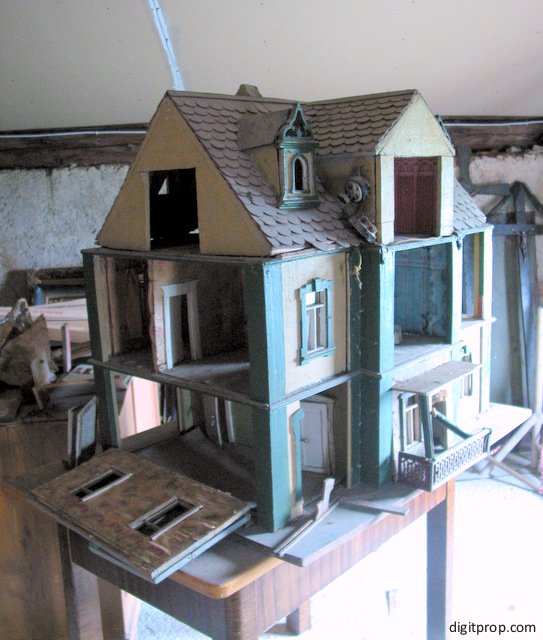

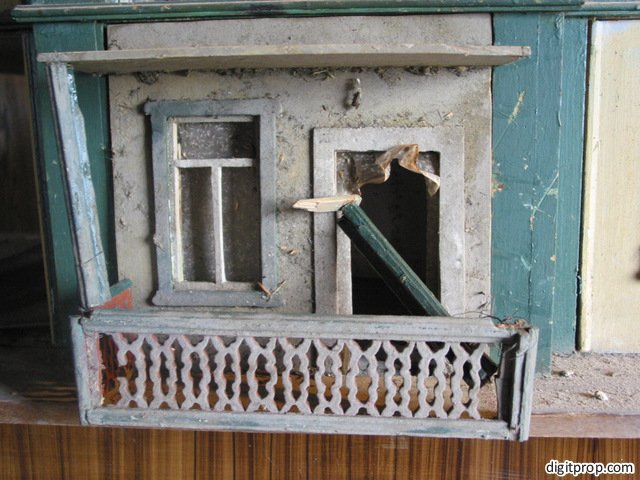





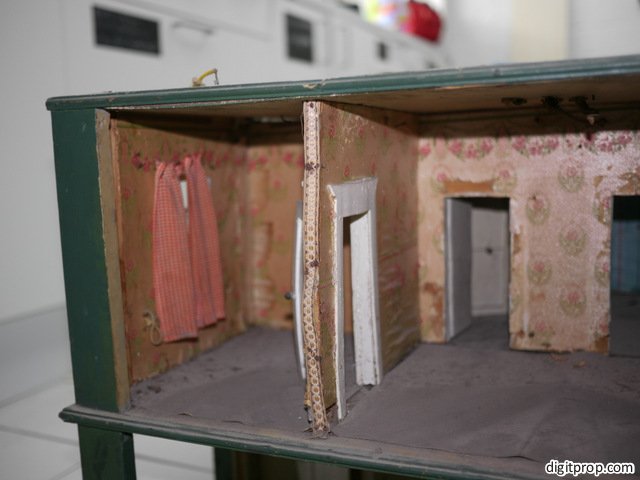








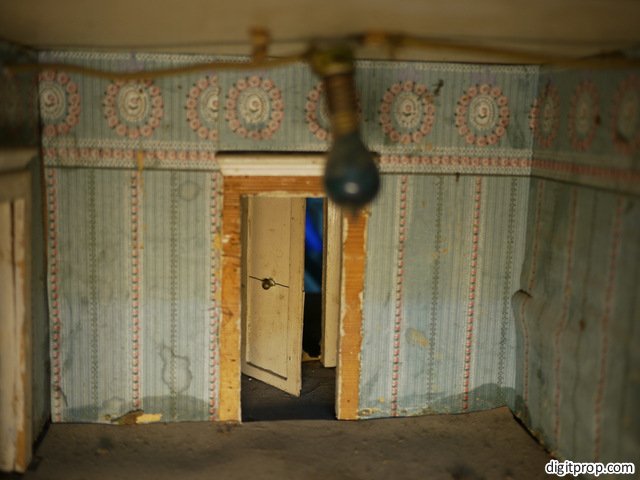


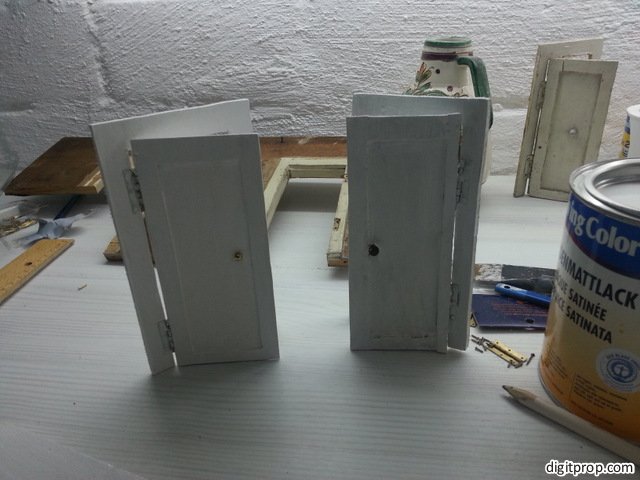



































OH, P.S.
1 to 1 is a classic scale for Dollhouses in general, but older homes were mixed pieces and all manner of finishes. As an example, England use to have a smaller scale in the early part of the 20th century. Look on line or research books, there are a zillion books to help you find example, periods and patterns.
I delight in you detail and application. It is from my advantage point far better you restored what remained, then build anew. This a historic home restoration versus a run of the mill commercial contemporary interpretation of a classic period home. “A house is not always a home. ” A home takes time and has layers of love…
IF YOU WANT TO FOLLOW ON…
Look at German period homes on line, maybe get window frames made for the larger openings, a front door, etc. Why not ? Think of stain glass or clear glass patterns for the upper portion of the larger windows, the leading could be done with liquid lead (in a tube).
As you explore you will come up many other suitable ideas. It’s a period piece so have fun, be creative, live in it today or yesteryear. My Grandparents were born before the period your home was built, I know grandparents who are 35… You and your family should just enjoy the house, your grandchildren will not be gentle at first so if they are to play with it, then make simple solid furniture pieces for the early days.
Thank you very much for your detailed comment, Marjorie! I really appreciate the encouragement and tips! Stain glass is actually quite an intriguing idea. Will definitely look into this. It’s a journey, and I and hopefully my children will continue to work on the house.
Dear friend,
What fun it has been for me to watch your project progress.
I also have built a “Townhouse” dollhouse for my children and grandchildren.
Now I ned to think where it will find its next permanent home, hopefully not in a drafty
attic. I hope you will built an other dollhouse, perhaps one totaly diffrent.
Have fun!
Brigitte
Thanks for the feedback! Take good care of your doll house, your children and later generations will definitely appreciate it.
After all the work I put into this one, and the things I learned along the way, I certainly am inspired to build another one. Let’s see…
Beautiful. What scale? My father made 1″:1′ scale dollhouses for his two granddaughters so I can appreciate the work that goes into these. Did you have the necessary skills before the build or learn them throu OJT?
Mine is a 1″:1′ scale as well (1:12). I wouldn’t claim that I had or even now have the skills. There are extremely talented and skilled people out there who do much more perfect work. I learned a lot on the project (which took me several years, on and off).